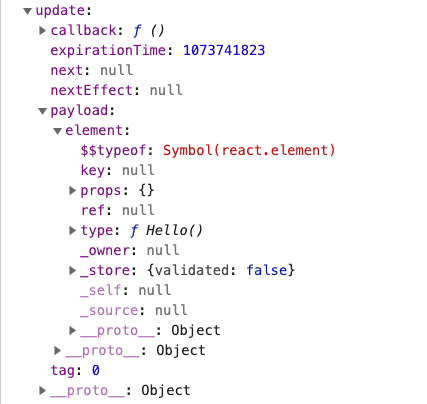scheduleRootUpdate
scheduleRootUpdate 这个函数主要执行了两个操作 1个是创建更新createUpdate并放到更新队列enqueueUpdate, 1个是执行sheculeWork函数
function scheduleRootUpdate(
current: Fiber,
element: ReactNodeList,
expirationTime: ExpirationTime,
callback: ?Function,
) {
const update = createUpdate(expirationTime);
// Caution: React DevTools currently depends on this property
// being called "element".
update.payload = {element};
callback = callback === undefined ? null : callback;
if (callback !== null) {
update.callback = callback;
}
flushPassiveEffects();
enqueueUpdate(current, update);
scheduleWork(current, expirationTime);
return expirationTime;
}
先看createUpdate函数分析, 它直接返回了一个包含了更新信息的对象
function createUpdate(expirationTime) {
return {
// 优先级
expirationTime: expirationTime,
// 更新类型
tag: UpdateState,
// 更新的对象
payload: null,
callback: null,
// 指向下一个更新
next: null,
// 指向下一个更新effect
nextEffect: null
};
}

可以看到payload就是我们应用对应的ReactElement。type就是构造函数
enqueueUpdate
调用enqueueUpdate把上述的Update加入到HostRoot的updateQueue , 这个方法会在setState中再作介绍。
接下来就是scheduleWork了,它是render阶段真正的开始。在开始之前有必要介绍一些其他知识,比如全局变量,expirationTime等